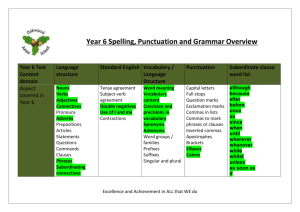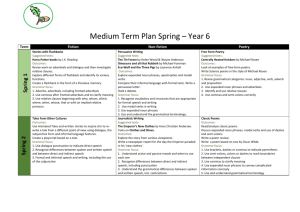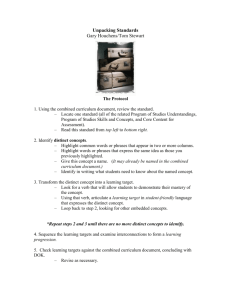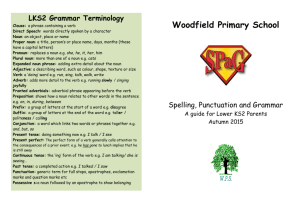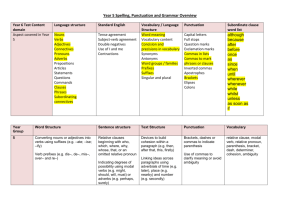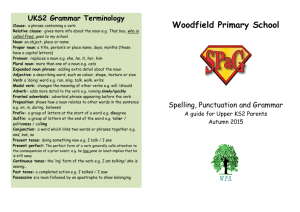Progression of grammar, punctuation and terminology
advertisement
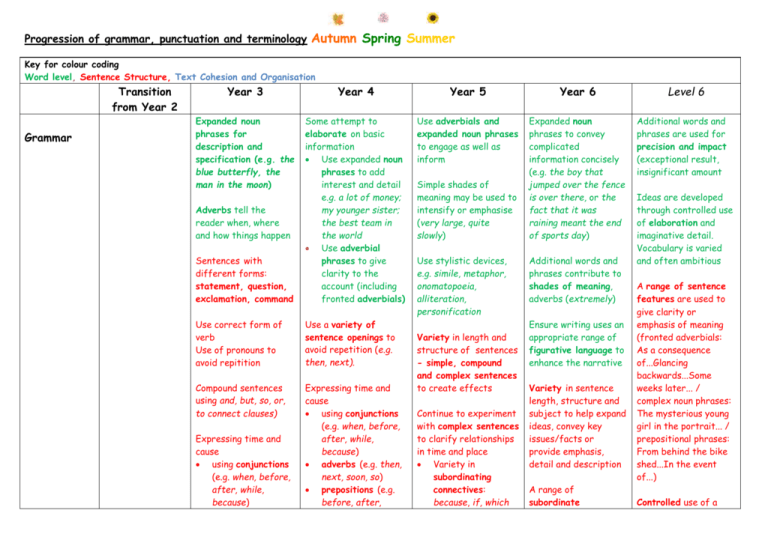
Progression of grammar, punctuation and terminology Autumn Spring Summer Key for colour coding Word level, Sentence Structure, Text Cohesion and Organisation Transition from Year 2 Grammar Year 3 Year 4 Year 5 Year 6 Expanded noun phrases for description and specification (e.g. the blue butterfly, the man in the moon) Use adverbials and expanded noun phrases to engage as well as inform Expanded noun phrases to convey complicated information concisely (e.g. the boy that jumped over the fence is over there, or the fact that it was raining meant the end of sports day) Sentences with different forms: statement, question, exclamation, command Some attempt to elaborate on basic information Use expanded noun phrases to add interest and detail e.g. a lot of money; my younger sister; the best team in the world Use adverbial phrases to give clarity to the account (including fronted adverbials) Use correct form of verb Use of pronouns to avoid repitition Use a variety of sentence openings to avoid repetition (e.g. then, next). Compound sentences using and, but, so, or, to connect clauses) Expressing time and cause using conjunctions (e.g. when, before, after, while, because) adverbs (e.g. then, next, soon, so) prepositions (e.g. before, after, Adverbs tell the reader when, where and how things happen Expressing time and cause using conjunctions (e.g. when, before, after, while, because) Simple shades of meaning may be used to intensify or emphasise (very large, quite slowly) Use stylistic devices, e.g. simile, metaphor, onomatopoeia, alliteration, personification Variety in length and structure of sentences - simple, compound and complex sentences to create effects Continue to experiment with complex sentences to clarify relationships in time and place Variety in subordinating connectives: because, if, which Additional words and phrases contribute to shades of meaning, adverbs (extremely) Ensure writing uses an appropriate range of figurative language to enhance the narrative Variety in sentence length, structure and subject to help expand ideas, convey key issues/facts or provide emphasis, detail and description A range of subordinate Level 6 Additional words and phrases are used for precision and impact (exceptional result, insignificant amount Ideas are developed through controlled use of elaboration and imaginative detail. Vocabulary is varied and often ambitious A range of sentence features are used to give clarity or emphasis of meaning (fronted adverbials: As a consequence of...Glancing backwards...Some weeks later... / complex noun phrases: The mysterious young girl in the portrait... / prepositional phrases: From behind the bike shed...In the event of...) Controlled use of a adverbs (e.g. then, next, soon, so) prepositions (e.g. before, after, during, in, because of) Use a variety of conjunctions to clarify relationship between ideas (e.g. but, so, when, because, while) Beginning to vary sentence openings, e.g. not always starting with name or pronoun Use appropriate connectives to structure ideas logically, including for time (then, after, first) Uses when, if, that, or because for subordination The consistent use of present tense versus past tense throughout texts use of the continuous form of verbs to mark actions in progress (e.g. she is during, in, because of) Use a variety of conjunctions to clarify relationship between ideas (e.g. but, so, when, because, while) a wider range of conjunctions e.g. either, both, until, although Use some complex sentences e.g. After running for the bus, I collapsed on the seat. Appropriate choice of pronoun or noun within a sentence to avoid ambiguity and repetition consistency with the use of the first and third person Usually have correct subject and verb agreement (was/were) Use of the perfect form of verbs to mark relationships of time and cause (e.g. I have written it down so we can check what he (because the rain can damage their skin...which was strange...If she could...). Experiment with the position of subordinate clauses to create effect Use relative clauses beginning with who, which, where, why, or whose Tense choice generally appropriate correct subject/verb agreement Indicating degrees of possibility using modal verbs (e.g. might, should, will, must) or adverbs (e.g. perhaps, surely) Use of the passive voice to affect the presentation of information in a sentence (e.g. I broke the window in the greenhouse versus The window in the connectives (whilst, until, despite) with possible use of several subordinate clauses to aid economy of expression (Because of their courageous efforts, all of the passengers were saved, which was nothing short of a miracle... ‘Whilst under my roof, you will obey my rules, which are clearly displayed’) Use structures typical of informal speech and formal speech and writing, such as the use of question tags, e.g. He’s your friend, isn’t he? A range of verb forms develops meaning and maintains appropriate tense choice (it will probably leave of its own accord...we could catch a later train, but will we arrive on time?) Emphasis may be created through word order variety of simple and more complex sentences contribute to clarity of purpose and overall effect on the reader Subordinate connectives may be manipulated for emphasis A range of cohesive devices contribute to the effect of the text on the reader and the placing of emphasis for impact (e.g. precise adverbials as sentence starters, a range of appropriate connectives, subject specific vocabulary, select use of pronoun referencing, complex noun phrases, prepositional phrases) . Varying levels of formality are adopted according to purpose and audience (appropriate use of controlled informality, shifts between formal narrative and informal dialogue) drumming, he was shouting) Ideas in sections grouped by content, some linking by simple pronouns said.) Tense choice generally appropriate to task including some use of modals (can, will) Devices to build cohesion within a paragraph Connectives e.g. then, after that, this, firstly use of pronouns or adverbials greenhouse was broken) Write with clarity and an impersonal style Link ideas across paragraphs using adverbials of time (e.g. later), place (e.g. nearby) and number (e.g. secondly) accurate adaptation of verb phrases use of passive (the centre has been visited often) Use a more formal tone with confidence when appropriate Show some contrast between colloquial or standard English Use of the subjunctive in some very formal writing and speech (e.g. If she were the President, things would be much better Link ideas across paragraphs using a wider range of cohesive devices: semantic cohesion e.g. repetition of a word or phrase Grammatical connections (e.g. the use of adverbials such as on the other hand, in contrast, or as a consequence) Viewpoint is convincing and generally sustained throughout a piece (e.g. authoritative expert view, opposing opinions) A range of stylistic features contribute to the effect of the text (e.g. rhetorical questions, repetition and figurative language). Verb forms are mostly controlled and are consistently adapted to the form of writing (It would be helpful if you could let me know, as this will enable me to take further action) Punctuation Apostrophes to mark contracted forms in spelling Apostrophes to show possession Sentence demarcation with capital letters and full stops usually accurate Some accurate use of question marks and exclamation mark Uses commas to separate items in a list Use commas after fronted adverbials Use of speech marks to punctuate direct speech Apostrophes to mark singular and plural possession (e.g. the girl’s name, the boys’ boots) Full stops, capital letters, exclamation marks and question marks mostly accurate; commas used in lists. Beginning to use speech marks to punctuate direct speech Accurately use commas in lists Use of speech marks to punctuate direct speech Using commas other than in lists more confidently e.g. after fronted adverbials (e.g. Later that day, I heard the bad news.) Use and experiment with a range of punctuation, although not always Read writing back, with appropriate pauses Use apostrophe for both omission and singular possession Use of commas to clarify meaning or avoid ambiguity separate phrases or clauses accurately Use speech punctuation (inverted commas) correctly with a new line for each speaker Brackets, dashes or commas to indicate parenthesis (a word or phrase added as an explanation or afterthought) Use colon and semi-colon How hyphens can be used to avoid ambiguity (e.g. man eating shark versus man-eating shark) Use commas within sentences to avoid ambiguity in relating elements and clauses Use of the semicolon, colon and dash to indicate a stronger subdivision of a sentence than a comma Punctuation of bullet points to list information Use grammatically complex sentences (i.e. is able to position and punctuate subordinate clauses) Use a wide range of well controlled punctuation for effect, meaning Syntax and full range of punctuation are consistently accurate in a variety of sentence structures, with occasional errors in ambitious structures Grammatical Terminology Verb adjective noun adverb connective statement question exclamation command comma apostrophe Past tense Present tense accurately e.g. brackets, semicolon, colon and dash adjective adverb pronoun possessive pronoun adverbial phrase noun phrase preposition simile conjunction connective subordinate clause cohesion paragraph inverted commas (or ‘speech marks’) bracket dash and pace simile metaphor onomatopoeia alliteration personification determiner modal verb complex sentence subordinate clause adverbial phrase relative clause relative pronoun colon semi-colon bullet points noun phrases active and passive voice tense choice ambiguity elaboration parenthesis subject and object figurative language hyphen figurative language complex sentence noun phrase subordinate clause adverbial semi-colon colon dash verb forms Subordinate connectives precision and impact formal tone colloquial and standard English cohesion subjunctive elaboration cohesive devices formality viewpoint
